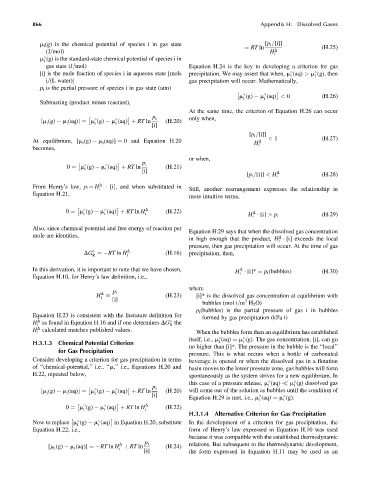Page 911 - Fundamentals of Water Treatment Unit Processes : Physical, Chemical, and Biological
P. 911
866 Appendix H: Dissolved Gases
m i (g) is the chemical potential of species i in gas state [p i =[i]]
¼ RT ln (H:25)
(J=mol) H D
i
m (g) is the standard-state chemical potential of species i in
i
gas state (J=mol) Equation H.24 is the key to developing a criterion for gas
[i] is the mole fraction of species i in aqueous state [mols precipitation. We may assert that when, m (aq) > m (g), then
i i
i=(L water)] gas precipitation will occur. Mathematically,
p i is the partial pressure of species i in gas state (atm)
m (g) m (aq) < 0 (H:26)
i i
Subtracting (product minus reactant),
At the same time, the criterion of Equation H.26 can occur
p i only when,
[m (g) m (aq)] ¼ m (g) m (aq) þ RT ln (H:20)
i
i
i
i
[i]
[p i =[i]]
At equilibrium, [m (g) m (aq)] ¼ 0 and Equation H.20 H i D < 1 (H:27)
i
i
becomes,
or when,
p i
0 ¼ m (g) m (aq) þ RT ln (H:21)
i i
[i] D
[p i =[i]] < H (H:28)
i
From Henry’s law, p i ¼ H D [i], and when substituted in
i Still, another rearrangement expresses the relationship in
Equation H.21,
more intuitive terms,
D
0 ¼ m (g) m (aq) þ RT ln H (H:22) D
i i i (H:29)
H [i] > p i
i
Also, since chemical potential and free energy of reaction per
Equation H.29 says that when the dissolved gas concentration
mole are identities, D
in high enough that the product, H [i] exceeds the local
i
pressure, then gas precipitation will occur. At the time of gas
DG ¼ RT ln H D (H:16) precipitation, then,
i
R
In this derivation, it is important to note that we have chosen, H [i]* ¼ p i (bubbles) (H:30)
D
i
Equation H.10, for Henry’s law definition, i.e.,
where
D p i
i
H (H:23) [i]* is the dissolved gas concentration at equilibrium with
[i] 3
bubbles (mol i=m H 2 O)
p i (bubbles) is the partial pressure of gas i in bubbles
Equation H.23 is consistent with the literature definition for formed by gas precipitation (kPa i)
D
H as found in Equation H.16 and if one determines DG the
i R
D
H calculated matches published values.
i When the bubbles form then an equilibrium has established
itself, i.e., m (aq) ¼ m (g). The gas concentration, [i], can go
i
i
H.3.1.3 Chemical Potential Criterion no higher than [i]*. The pressure in the bubble is the ‘‘local’’
for Gas Precipitation
pressure. This is what occurs when a bottle of carbonated
Consider developing a criterion for gas precipitation in terms beverage is opened or when the dissolved gas in a flotation
of ‘‘chemical-potential,’’ i.e., ‘‘m,’’ i.e., Equations H.20 and basin moves to the lower pressure zone, gas bubbles will form
H.22, repeated below, spontaneously as the system strives for a new equilibrium. In
this case of a pressure release, m (aq) m (g) dissolved gas
i
i
p i
[m (g) m (aq)] ¼ m (g) m (aq) þ RT ln (H:20) will come out of the solution as bubbles until the condition of
i i i i
[i]
Equation H.29 is met, i.e., m (aq) ¼ m (g).
i i
D
0 ¼ m (g) m (aq) þ RT ln H (H:22)
i i i
H.3.1.4 Alternative Criterion for Gas Precipitation
Now to replace m (g) m (aq) in Equation H.20, substitute In the development of a criterion for gas precipitation, the
i i
Equation H.22, i.e., form of Henry’s law expressed in Equation H.10 was used
because it was compatible with the established thermodynamic
D
[m (g) m (aq)] ¼ RT ln H þ RT ln p i (H:24) relations. But subsequent to the thermodynamic development,
i
i
i
[i] the form expressed in Equation H.11 may be used as an

